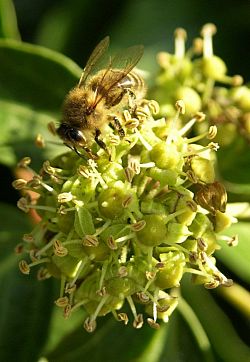The honey and the ivy – why gardeners’ foe is the bees’ friend
Ivy, often maligned as a garden pest, is vital to honey bees and other pollinators seeking food in autumn, new research from the University of Sussex reveals.
 Honey bee on ivy flowers.
Honey bee on ivy flowers.
The research, carried out by scientists at the Laboratory of Apiculture and Social Insects (LASI), is published online today (Friday 26 April) in the journal Insect Conservation and Diversity.
The researchers surveyed ivy flowers from rural and urban locations to count the honey bees and other insects foraging for nectar and pollen. They also identified the pollen brought back to hives by honey bee workers to determine the proportion from ivy and then surveyed ivy to determine how widespread it is.
In addition, the researchers measured the sugar concentration in nectar collected from ivy flowers by honey bee workers, and determined what proportion of honey bee foragers on ivy were collecting nectar versus pollen.
The data collected from hives on campus, from nearby Falmer village and from Brighton’s Dorothy Stringer School showed that, contrary to what might be expected, bee foraging distances decreased from summer to the autumn.
As ivy blooms mainly in September and October, this suggested that the plant was having a beneficial effect on bee foraging, resulting in the bees having to fly shorter distances to find high-quality flowers.
Having access to high-quality supplies of nectar and pollen late on in the flower season improves the chances of successful over-wintering for the hive.
The main findings were:
- On average 89 per cent of pollen pellets brought by worker bees to hives were from ivy. There was no difference between hives located in an urban area (Brighton) versus a rural area (University of Sussex).
- 80 per cent of honey bees foraging on ivy were collecting nectar, not pollen.
- Ivy nectar was high quality, with a lot of sugar (49 per cent).
- Ivy flowers are visited by a wide range of insects, such as late-season butterflies, hover flies, other types of flies, wasps, bumble bees, and the ivy bee (a bee that specialises on ivy).
- Ivy is common and available to insects in both town and countryside.
PhD student Mihail Garbuzov, who led the study, says: “In September and October ivy is the main game in town if you want nectar or pollen. On a sunny day you will be amazed at how many insects there are on it.”
Professor Francis Ratnieks, who is Director of LASI and who co-authored the study, says: “Our research shows that ivy is hugely important to honey bees and other flower-visiting insects, such as late-season butterflies and hover flies, in the autumn. In fact, if ivy did not exist we would probably try to invent it.
“Our study provides further evidence of the benefits of ivy to wildlife, which we hope will be used to inform decisions of householders, land owners, and environment managers.”
